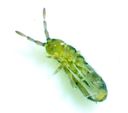Isotominae
Isotominae
Classification
- Phylum: Arthropoda
- Subphylum: Hexapoda
- Class: Collembola
- Order: Entomobryomorpha
- Family: Isotomidae
- Subfamily: Isotominae
Pronunciation
How to pronounce Isotominae: /ˌaɪsəˈtɒmɪniː/
These audio files are automatically generated. While they are not always 100% accurate, they are a good starting point.
Images






Summary
Isotominae is a subfamily of elongate-bodied springtails under the family Isotomidae, housing around 16 genera and at least 100 described species.
Physical Characteristics
Elongate-bodied springtails, typically small in size, adapted for jumping.
Identification Tips
Look for elongated bodies and a furcula (jumping organ) at the rear, which can be used to distinguish them from other springtails.
Habitat
Found in a variety of habitats including soil, leaf litter, and decaying organic matter, often in moist environments.
Distribution
Widespread, found throughout North America and globally, with about 460 species in approximately 50 genera worldwide.
Diet
Primarily detritivores, feeding on decaying organic matter, fungi, and bacteria in their environment.
Life Cycle
Undergo hemimetabolous development; they progress from eggs to juvenile stages and finally to adults without a distinct larval stage.
Reproduction
Usually reproduce sexually, with some species capable of parthenogenesis.
Ecosystem Role
Play a crucial role in soil aeration and nutrient cycling by breaking down organic matter.
Collecting Methods
- Soil sifting
- Pitfall traps
- Leaf litter sampling
Preservation Methods
- Alcohol preservation
- Freezing
- Drying
Similar Taxa
Tags
- Isotominae
- Collembola
- springtails
- Isotomidae
- soil organisms